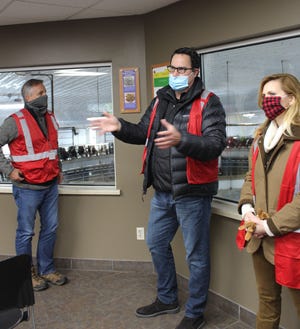Rebuilding the relationship between government and farmers

Farmers are the great stewards of our United States. They sustain our land, feed our people, and are one of our strongest allies in our mission to protect public health and the environment. They are the backbone of our economy. As President Trump stated earlier this year, “if we want America to thrive and grow in the future, then we must ensure that America’s farms flourish and prosper.”
To ensure American agriculture succeeds, the Trump Administration has rebuilt the relationship between government and the farming community, deviating from the adversarial approach taken by previous administrations.
We’ve sat down with local farmers here in Wisconsin and across the country to learn about their operations, how they produce their goods and crops, and their efforts to preserve the natural resources we all rely on. As we listened, it became clear the farming community has been facing a dual challenge: the lack of cooperation from previous administrations left them without a voice in Washington, and the overly burdensome regulations imposed on them as a result became as unpredictable as the weather.
Nowhere was this regulatory uncertainty more evident than in the Obama administration’s use of the Clean Water Act to expand the definition of “waters of the United States” (WOTUS). The overly broad definition gave the federal government jurisdiction over any waterbody the rule deemed “navigable,” including countless stock and farm ponds and wetlands, agricultural ditches, and channels that flow only after it rains. Famously, the definition was so over-reaching that clarification was necessary in the rule to point out that puddles were not regulated by the federal government.
Under the previous administration’s WOTUS rule, many farmers, businesses and landowners would have had to spend tens of thousands of dollars on lawyers and consultants to determine whether waters and wetlands on their land fall under the control of the U.S. EPA and the Army Corps of Engineers. According to one analysis done by the American Farm Bureau Federation, waters and wetlands in an estimated 92% of the landmass in Wisconsin may have come within federal jurisdiction.
Thirty-one states and 53 non-state parties, including groups representing farming and another important Wisconsin sector, forestry, filed complaints and petitions challenging the rule in multiple federal district and appellate courts. As a result of the litigation firestorm the WOTUS rule faced, it never took effect nationwide and has been ruled “unlawful” by two federal courts.
An already tenuous trust between the government and the farming community was broken. The president has been clear about this administration’s support for agriculture and rural America, and our priority at EPA has been to restore this trust.
One of the first things EPA did to restore trust, under the direction of President Trump, was work with the Army Corps to take the Obama administration’s landgrab off the books and issue a new rule – the Navigable Waters Protection Rule – revising the WOTUS definition to provide clear and limited categories of waters and wetlands that are regulated by the federal agencies while giving more control to the states, as Congress intended, to manage their land and water resources. The Trump Administration’s rule contains exclusions for water features that traditionally have not been regulated under the Clean Water Act. And to provide additional clarity to landowners and businesses, EPA and the Army Corps defined key terms in the regulatory text that have never been defined before.
Our commitment to the agricultural community goes beyond safeguarding them from costly, duplicative regulations. We are working as partners to solve some of our nation’s most pressing challenges and to create better environmental outcomes.
The Trump Administration views farmers as our nation’s first conservationists. Earlier this year, we had the opportunity to tour the Door-Kewaunee Demonstration Farm Network to see their conservation practices aimed at helping to improve water quality in the area. This cooperative effort receives funding from the Great Lakes Restoration Initiative (GLRI)—our primary vehicle for protecting our Great Lakes.
Addressing excess nutrients in our waters requires creative solutions. Through the GLRI, funded at the highest levels in its existence under the Trump Administration, EPA is building on existing state, local and tribal efforts to support innovative technologies that will deliver critical water quality improvements. Among the GLRI grant recipients is NEW Water in Green Bay, which will implement a cost-share program for the installation of permanent vegetative buffers on 35 acres of headwater streams in the Fox River watershed.
Looking towards the future, EPA signed a first-time Memorandum of Understanding (MOU) with the National FFA Organization, which has over 700,000 student members across all 50 states, Puerto Rico and the Virgin Islands. The MOU will facilitate opportunities between EPA and National FFA Chapters and will further outreach on EPA’s environmental education efforts in rural areas. Working together, we are establishing a partnership with America’s future farming leaders that will benefit administrations that follow.
As President Trump declared during his address at the American Farm Bureau Federation's 100th annual convention, “the greatest harvest is yet to come.” For our part, the agricultural community here in Wisconsin – and across the United States – has our commitment that EPA will work with farmers to ensure American agriculture remains the best in the world.

Kurt Thiede serves as the Regional Administrator for EPA Region 5. His responsibilities include overseeing environmental protection efforts in the Great Lakes states of Illinois, Indiana, Michigan, Minnesota, Ohio and Wisconsin, as well as 35 federally recognized tribal governments.